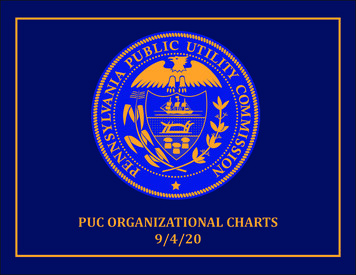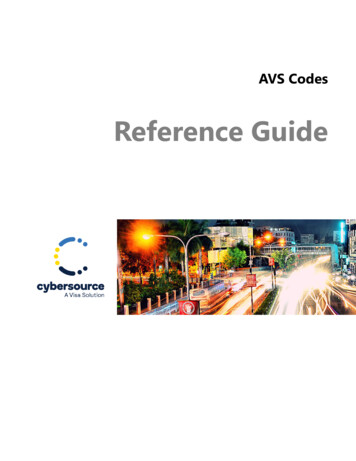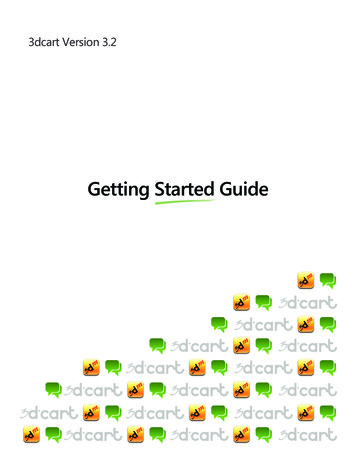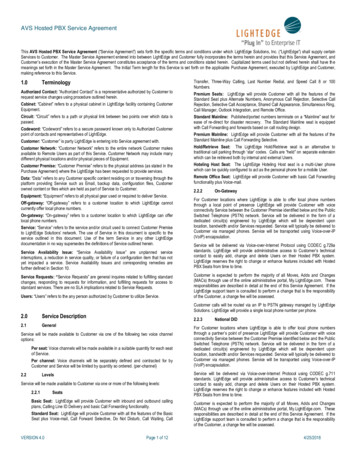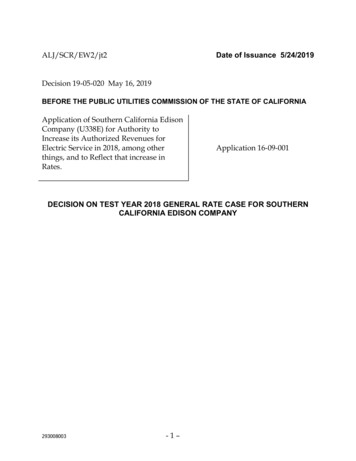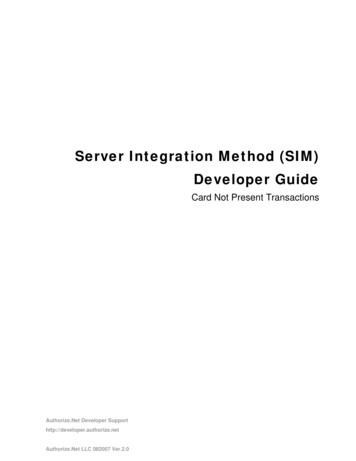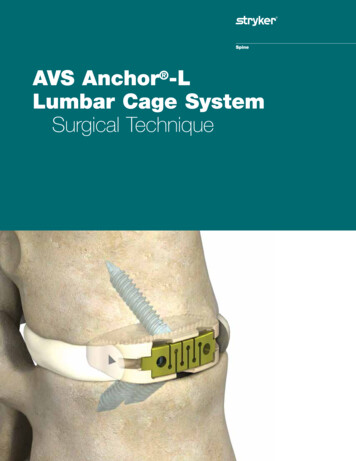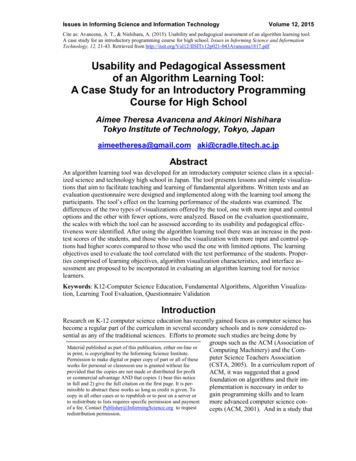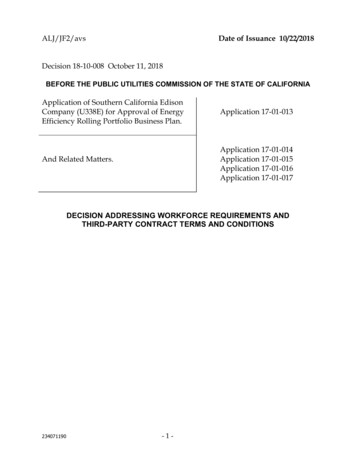
Transcription
ALJ/JF2/avsDate of Issuance 10/22/2018Decision 18-10-008 October 11, 2018BEFORE THE PUBLIC UTILITIES COMMISSION OF THE STATE OF CALIFORNIAApplication of Southern California EdisonCompany (U338E) for Approval of EnergyEfficiency Rolling Portfolio Business Plan.Application 17-01-013Application 17-01-014Application 17-01-015Application 17-01-016Application 17-01-017And Related Matters.DECISION ADDRESSING WORKFORCE REQUIREMENTS ANDTHIRD-PARTY CONTRACT TERMS AND CONDITIONS234071190-1-
A.17-01-013 et al. ALJ/JF2/avsTABLE OF CONTENTSTitlePageDECISION ADDRESSING WORKFORCE REQUIREMENTS AND THIRDPARTY CONTRACT TERMS AND CONDITIONS . 2Summary . 21. Background. 32. Workforce Quality Requirements . 52.1. General Applicability of Workforce Requirement . 62.1.1. Comments of Parties . 62.1.2. Discussion. 112.2. HVAC Standard . 142.2.1. Project and Size Applicability . 152.2.1.1. Comments of Parties . 152.2.1.2. Discussion . 162.2.2. Applicability to Upstream and Midstream Actors . 172.2.2.1. Comments of Parties . 172.2.2.2. Discussion . 182.2.3. Definition of Journey or Apprenticeship . 182.2.3.1. Comments of Parties . 182.2.3.2. Discussion . 192.3. Specific Lighting Controls Standard . 212.3.1. Certification Provider . 212.3.1.1. Comments of Parties . 212.3.1.2. Discussion . 232.3.2. Project Size Applicability . 242.3.2.1. Comments of Parties . 242.3.2.2. Discussion . 252.3.3. Applicability to Upstream and Midstream Actors . 252.3.3.1. Comments of Parties . 262.3.3.2. Discussion . 263. Standard Terms and Conditions for Third Party Contracts . 273.1. Performance Assurance and Bonding . 273.1.1. IOU Proposal. 273.1.2. Comments of Parties . 273.1.3. Discussion. 283.2. Financial Statements. 283.2.1. IOU Proposal. 28-i-
A.17-01-013 et al. ALJ/JF2/avsTABLE OF CONTENTSCon't.TitlePage3.2.2. Comments of Parties . 293.2.3. Discussion. 293.3. Background Checks . 293.3.1. IOU Proposal. 303.3.2. Comments of Parties . 313.3.3. Discussion. 323.4. Termination for Convenience . 343.4.1. IOU Proposal. 353.4.2. Comments of Parties . 363.4.3. Discussion. 373.5. Termination/Modification of Commission Order . 383.5.1. IOU Proposal. 383.5.2. Comments on Parties . 383.5.3. Discussion. 394. Modifiable Terms and Conditions . 414.1. Payment Terms and Incentive Structure. 414.1.1. IOU Proposal. 424.1.2. Comments of Parties . 434.1.3. Discussion. 434.2. Progress and Evaluation Metrics . 444.2.1. IOU Proposal. 444.2.2. Comments of Parties . 464.2.3. Discussion. 474.3. Intellectual Property . 484.3.1. IOU Proposal. 484.3.2. Comment of Parties . 494.3.3. Discussion. 504.4. Definition of Small Business Enterprise . 524.4.1. IOU Proposal. 524.4.2. Comments of Parties . 524.4.3. Discussion. 534.5. Provisions Related to Disadvantaged Workers . 534.5.1. IOU Proposal. 544.5.2. Comments of Parties . 54- ii -
A.17-01-013 et al. ALJ/JF2/avsTABLE OF CONTENTSCon't.TitlePage4.5.3. Discussion. 584.6. Coordination with Other Program Administrators . 604.6.1. IOU Proposal. 604.6.2. Comments of Parties . 604.6.3. Discussion. 615. Other Issues Raised by Parties Related to Standardor Modifiable Contract Provisions . 615.1. Customer Incentives, Repository for All Program Rules, andApplicability of Other Commission Requirements . 615.2. Discussion . 616. Comments on Proposed Decision . 627. Assignment of Proceeding . 68Findings of Fact . 68Conclusions of Law . 70ORDER . 76Attachment A: Required Standard Terms and Conditions forThird Party Contracts with Investor Owned UtilitiesAttachment B: Modifiable Terms and Conditions forThird Party Contracts with Investor-Owned UtilitiesAppendix A – List of Appearances- iii -
A.17-01-013 et al. ALJ/JF2/avsDECISION ADDRESSING WORKFORCE REQUIREMENTS ANDTHIRD-PARTY CONTRACT TERMS AND CONDITIONSSummaryThis decision addresses workforce standards required to be applied by allenergy efficiency program administrators (PAs) to all programs meeting certainsize and measure criteria in their business plan portfolios. The workforcestandards are applied to large non-residential projects involving heating,ventilation, and air-conditioning measures, as well as lighting controls. Theseare intended as a starting point for potentially more far-reaching requirements inthe future, in coordination with the evaluation and adoption by the CaliforniaEnergy Commission of a "responsible contractor policy" as set forth by Senate Bill(SB) 350 (DeLeon, 2015). The workforce standards are required to be included inthe first round of third-party solicitations that begin after issuance of thisdecision, and in place for non-third-party or other new or pre-existing programsby July 1, 2019. In addition, we request a stakeholder process to begin in mid2020 to discuss potential extension of the workforce standards or implementationof new standards, after consideration of experience with the standards requiredin this decision.In addition, the decision sets forth the provisions of required standard andmodifiable terms and conditions that utility program administrators mustinclude in their contracts with third-party designers and implementers of energyefficiency programs within their business plan portfolios. The utilities arerequired to include all of the proposed standard contract terms included in theirjoint motion for adoption of the terms, including those not specifically discussedherein. Any additional terms included by utilities, including modifiable terms,must not conflict or otherwise undermine the meaning or intent of the standard-2-
A.17-01-013 et al. ALJ/JF2/avsand modifiable terms adopted in this decision. The modifiable terms are also thestarting point for negotiation, and may only be modified by mutual agreement ofthe utility and the third party. Non-utility PAs are also encouraged to utilizethese contract terms.The standard terms and conditions addressed herein include: Performance assurance and bonding Financial statements Background checks Termination for convenience (which is eliminated by this decision) Termination or modification in response to Commission order.The modifiable terms and conditions addressed herein include: Payment terms and incentive structure Progress and evaluation metrics Intellectual property Definition of small business enterprises Provisions related to disadvantaged workers Coordination with other PAs.This proceeding remains open.1. BackgroundIn October 2015, the Commission adopted Decision (D.) 15-10-028, whichestablished a “Rolling Portfolio” process for regularly reviewing and revisingenergy efficiency program administrators’ portfolios.In August 2016, the Commission adopted D.16-08-019, providing furtherguidance on rolling portfolio elements including changes to third partyprograms and their administration.D.16-08-019 also directed the investor-owned utility (IOU) energyefficiency PAs, Marin Clean Energy (MCE), and existing or new regional energynetworks (RENs) to file business plan proposals for the 2018-2025 period by-3-
A.17-01-013 et al. ALJ/JF2/avsJanuary 15, 2017. Southern California Edison Company (SCE), San Diego Gas &Electric Company (SDG&E), Pacific Gas and Electric Company (PG&E), SouthernCalifornia Gas Company (SoCalGas), MCE, the San Francisco Bay Area REN(BayREN), Southern California REN (SoCalREN), and Tri-County REN (3C-REN)all filed timely business plan applications that were addressed (approved ormodified) in D.18-05-041.D.18-05-041 committed to a further opportunity for comment on certainworkforce requirements for the overall energy efficiency business plan portfoliosof all PAs. An Administrative Law Judge (ALJ) ruling was issued July 9, 2018,seeking additional comment from parties on the potential workforce standards.Timely comments were received from the following 26 parties: AGC, Inc.; theAssociation of Bay Area Governments (ABAG) on behalf of BayREN; Big SkyElectric, Inc.; the California Association of Sheet Metal and Air ConditioningContractors, National Association (CAL SMACNA); the California Efficiency Demand Management Council (CEDMC); CLEAResult; the Coalition for EnergyEfficiency (CEE); Cold Craft, Inc.; Collins Electrical Company (Collins); Countyof Ventura on behalf of the Tri-County Regional Energy Network (3C-REN);Electric Service & Supply Company of Pasadena( ESSCO); Foothill AirConditioning and Heating, Inc. (Foothill); the Institute of Heating and AirConditioning Industries (IHACI); Joint Committee on Energy and EnvironmentalPolicy (JCEEP); MCE; Morrow-Meadows Corporation; Nest Labs, Inc.; O’BryantElectric Inc. (O’Bryant); the Office of Ratepayer Advocates (ORA), now called theCalifornia Office of the Public Advocate (Cal PA); On Target Electric, Inc. (OnTarget); PG&E; SDG&E; Sierra Club; Small Business Utility Advocates (SBUA);SCE; SoCalGas; and Stockman’s Energy Inc. (Stockman’s).-4-
A.17-01-013 et al. ALJ/JF2/avsTimely reply comments were received from AGC; Atlas Heating and AirConditioning Co. (Atlas); CEDMC; CEE; CLEAResult; Cold Craft; IHACI;California State Labor Management Cooperation Committee for the InternationalBrotherhood of Electrical Workers and the National Electrical ContractorsAssociation (LMCC for IBEW/NECA); Natural Resource Defense Council(NRDC), Greenlining Institute, and MCE, jointly; Nest; ORA (Cal PA); SBUA;SCE; SoCalGas; and The Utility Reform Network (TURN).In addition, the Commission also separately adopted D.18-01-004,addressing the process for third party solicitations in the energy efficiency rollingportfolio framework in more detail.D.18-01-004, among other things, required the utility PAs to file a motionproposing the standard and modifiable contract terms and conditions to beapplied to their third-party solicitations. SDG&E, SoCalGas, SCE, and PG&Efiled a joint motion on March 19, 2018 with their proposed standard andmodifiable third-party contract terms.Timely responses to the March 19, 2018 Joint Motion were filed by CEDMC,CLEAResult, CEE, County of Los Angeles on behalf of SoCalREN, MCE, ORA,Oracle Utilities (Oracle), SBUA, and TURN.The utility PAs filed a joint reply to the comments from the above partieson April 13, 2018.2. Workforce RequirementsReflecting the discussion in D.18-05-041, an ALJ ruling was issued forcomment on July 9, 2018 which proposed two workforce standards to be appliedto all energy efficiency projects funded by ratepayers that meet the criteria asdescribed in the ruling. This means these requirements are proposed to apply toprograms designed and implemented by third parties, as well as to programs-5-
A.17-01-013 et al. ALJ/JF2/avsdesigned and implemented by program administrators, including IOUs, RENs,and CCAs.The two standards proposed are in the areas of heating, ventilation, andair conditioning (HVAC), and lighting controls projects.2.1. General Applicability ofWorkforce RequirementThe workforce standards in the July 9, 2018 ALJ Ruling were proposed toapply to larger non-residential projects involving HVAC and lighting controlsmeasures, as a starting point, while acknowledging that the California EnergyCommission (CEC) is tasked with developing an overall "responsible contractorpolicy" as part of its responsibilities under SB 350.This section discusses parties' general response to the concept of theimposition of workforce standards at all, and whether they can be expected toimprove installation quality and/or levels of energy savings delivered if thestandards are applied. The comments also touch on the potential impact ondisadvantaged workers in the State.2.1.1. Comments of PartiesNearly all parties filing comments on the proposed standards in theJuly 9, 2018 ALJ ruling would like to see modifications, with some partiessuggesting that workforce standards should not be imposed at all. While anumber of commenters had recommendations about specific aspects of theproposed standards, which will be discussed further below, the general overallresponse tended to fall into one of three categories: 1) parties generallysupporting the Commission imposing prescriptive standards, using aprogressive or tiered approach such as that suggested by CEE, where morestringent requirements are applied to larger and more complex projects;2) parties supporting a more conceptual approach based on knowledge, skills,-6-
A.17-01-013 et al. ALJ/JF2/avsand abilities (KSAs) relevant to the project needs; and 3) parties preferring thatthe Commission not impose workforce standards at all at this time.Related to the first category of proponents, the CEE proposal is for thefollowing approach:For Heating, Ventilation and Air Conditioning ProjectsTier 1 Residential HVAC Projects: For HVAC incentivesgreater than 500 and installed in residential buildings otherthan hotels and motels, (1) at least 50% of workers on thejobsite installing the ratepayer-subsidized project shall begraduates of relevant state-approved apprenticeshipprograms; or (2) at least 75% of workers on the jobsite shallhave at least two years of experience installing HVAC systemsand shall either (a) have industry-recognized certification ortraining specific to installation of the technology beinginstalled or (b) be enrolled in or have graduated from arelevant state-certified apprenticeship program. Thisrequirement shall not apply to Projects solely involvingthermostat change outs. This requirement shall not applywhere the incentive is paid to a manufacturer, distributor, orretailer of HVAC equipment unless proof of installation isrequired to receive the incentive or the manufacturer,distributor, or retailer installs or contracts for the installationof the measure.Tier 2 Nonresidential HVAC Projects: For HVAC incentivesgreater than 500 and installed in nonresidential buildings orhotels or motels, (1) at least 60% of workers on the jobsiteinstalling the ratepayer-subsidized project shall be graduatesof relevant state-approved apprenticeship programs; or (2) atleast 75% of workers on the jobsite shall have at least fiveyears of experience installing HVAC systems and 100% of theworkers installing the ratepayer-subsidized project shall either(a) have industry-recognized certification or credentialedtraining specific to installation of the technology beinginstalled or (b) be enrolled in or have graduatedfrom a relevant state-certified apprenticeship program. Thisrequirement shall not apply to Projects solely involving-7-
A.17-01-013 et al. ALJ/JF2/avsthermostat change outs. This requirement shall not applywhere the incentive is paid to a manufacturer, distributor, orretailer of HVAC equipment unless proof of installation of theHVAC measure is required to receive the incentive or themanufacturer, distributor, or retailer installs or contracts forthe installation of the measure.Tier 3 Very Large HVAC Projects: Where a program provides anindividual project, or group of projects within the same building orbuilding complex, more than 100,000 total in ratepayer-fundedassistance for the installation, modification, repair ormaintenance of HVAC-related energy efficiency measures, theprogram shall require this work to be performed by a “skilledand trained workforce” as that term is defined in PublicContract Code § 2601.For Lighting Controls ProjectsWhere a program provides an individual project, or group ofprojects within the same building or building complex, morethan 500 total in ratepayer-funded assistance for theinstallation, modification, repair or maintenance of lightingcontrol systems, the program shall require the contractor,project supervisor and at least 50% of the workers installinglighting controls to be California Advanced Lighting ControlsTraining Program (CALCTP) certified installers. Thisrequirement shall not apply where the incentive is paid to amanufacturer, distributor, or retailer of lighting controlsunless proof of installation of the lighting control is requiredto receive the incentive or the manufacturer, distributor, orretailer installs or contracts for the installation of the measure. 1Parties whose comments generally support this proposal include CEE,Sierra Club, CAL SMACNA, JCEEP, ORA, and most of the individual contractorsfiling comments. Most of these parties suggest that there should be standards1CEE August 6, 2018 comments at 3-4.-8-
A.17-01-013 et al. ALJ/JF2/avsapplied to residential projects as well as non-residential, in order to reach themaximum number of projects, and that the dollar threshold should generally bemuch smaller than proposed in the ALJ ruling, to capture the majority of projectsin the marketplace. ORA also suggests that there will likely be spillover effectson non-ratepayer-funded projects because of the imposition of standards in theseenergy efficiency projects.CEE also includes in its comment a recommendation for reliance onrequirements for a "skilled and trained workforce" as included in Public UtilitiesCode 388.2 and applied to state projects. CEE also cites to numerous otherprovisions of California law applying this concept in other contexts.IHACI agrees with the concept of a skilled and trained workforce, but doesnot find the definition appropriate to be applied in this context without furtherdetailed development of the definition.Nest supports the application of standards only to large non-residentialprojects, and would like self-installed projects exempted if the threshold isdropped lower. SBUA also supports application only to large projects.A number of the above parties also suggest that if there is a project sizethreshold, it should be based on the size of the incentive reserved in the program,rather than the total project cost, since the total incentive amount may be mucheasier to determine.The KSA approach was originally proposed by NRDC earlier in theproceeding,2 and is supported generally by CEDMC. The basic structure of theNRDC recommendation is that a non-financially-interested independent entity2See September 25, 2017 comments of NRDC at 7-9.-9-
A.17-01-013 et al. ALJ/JF2/avsthat is knowledgeable on the matter (e.g., a state agency or joint agencies), shouldidentify KSAs for a set of end uses or programs for the 2018 solicitations only.This is suggested as an interim measure until such time as the CEC adopts theresponsible contractor policy as required by SB 350. NRDC is also focused onensuring data collection to inform future action on these issues.CEDMC is concerned that additional workforce standards will imposecosts on the market, and that single-credential standards should be avoided infavor of criteria-based requirements. NRDC filed joint reply comments withGreenlining and MCE, generally supporting the concept that programimplementers have an opportunity to demonstrate equivalent KSAs to whatevermight be required by the Commission in a workforce standard.Those who are not convinced that workforce requirements will result insignificant project energy savings improvements include the PAs: MCE, SCE,and SDG&E, though SCE supports the lighting controls standard. The PAsgenerally support the approach in the IOUs' joint proposal for standard andmodifiable contract terms (discussed in Sections 3 and 4 of this decision), toallow third-party implementers to propose workforce standards that would beapplicable to each program approach proposed. Presumably, that would givethe PAs flexibility to determine the workforce standards applicable to their ownprograms as well.IHACI comments that there is no such thing as a workforce qualitystandard, but that there are quality installation standards, such as those of theAir Conditioning Contractors of America or the American Society of Heating,Refrigeration, and Air Conditioning Engineers. IHACI also suggests that theCommission look to the results of the Western HVAC Performance Alliance- 10 -
A.17-01-013 et al. ALJ/JF2/avs(WHPA) workforce, education, and training recommendations, which weredeveloped by industry stakeholders, for the HVAC project requirements.Finally, several parties commented that the imposition of any kind ofworkforce requirements could create barriers for disadvantaged workers.BayREN, CEDMC, SDG&E, and SCE are concerned about this impact, with SCEciting an evaluation study referring to both the financial and hiring barriers thatcould be created. BayREN also specifically mentions not only tuition barriers forthe training requirements, but also geographic barriers since many trainingopportunities are available only or primarily in metropolitan areas.CEE, CAL SMACNA, and Sierra Club do not believe that the standardswill create barriers for disadvantaged workers, and also point out that thepercentage requirements for each job site recommended by CEE should alleviatethis concern.2.1.2. DiscussionWe appreciate the thoughtful and constructive proposals, and the diversityof viewpoints, from all parties on how best to design and impose workforcestandards to help improve installation quality in the areas of HVAC and lightingcontrols projects. This entire effort by the Commission is designed to make astart toward workforce requirements, where more stringent or more broadlyapplicable requirements may be structured and phased in in the future. Whilethe Commission has expressed an interest in this area for a number of years, itremains elusive how to craft workforce standards that begin to makeimprovements in installation quality while ensuring the availability ofappropriately-trained workers and monitoring progress toward improvedenergy savings.- 11 -
A.17-01-013 et al. ALJ/JF2/avsAt this time, the Commission does not have experience with the practicalimplications of requiring workforce standards, and several studies cited byparties in their comments notwithstanding, does not see clear and convincingevidence showing direct correlation between workforce standards and increasedenergy savings. However, intuitively, better workforce training and qualityinstallation requirements should lead to improved savings results over time, aswell as increased availability of technicians with the proper training and skills.We also agree with the comments of CEDMC that the advent of more pay-forperformance and normalized metered energy consumption programs thatinherently reward savings performance should also be considered incombination with application of workforce requirements.We especially appreciate the tiered proposal of CEE; this is generally thedirection we would like to go, with different basic requirements for differenttypes of project sizes and complexities. However, in order to gain experiencewith the practical implications of imposing these standards, we prefer to start byphasing in the standards, starting with larger non-residential projects only,rather than adopt all of the requirements proposed by CEE all at once.We will require the standard we adopt here to be included in therequirements for third-party solicitations that are released after the issuance ofthis decision, as well as non-third-party programs and other existing programsby no later than July 1, 2019. We will then ask the program administrators tomake proposals to extend or augment these standards no later than their nextbusiness plan filings and based on experience with the requirements of thisdecision.We also agree with the recommendation by CEE, also supported byCEDMC and others, to base the project size thresholds on incentive dollars- 12 -
A.17-01-013 et al. ALJ/JF2/avsreserved, rather than total project cost. We will discuss the exact incentive sizethresholds further in the discussion of the specific HVAC and lighting controlsstandards below, with a basis in the recent project data provided by the PAs.The aspects of CEE's proposal related to requirements for certainpercentages of workers on job sites with certain credentials could be difficult toadminister. Conceptually, the approach has merit, since it appears the intent isnot to require that every last worker on each project have every certification orknowledge and experience, but to ensure that there is sufficient expertise amongthe team to ensure a quality installation. However, since we are applying ourrequirements for now only in the non-residential setting for larger projects, asdiscussed
air conditioning (HVAC), and lighting controls projects. 2.1. General Applicability of Workforce Requirement The workforce standards in the July 9, 2018 ALJ Ruling were proposed to apply to larger non-residential projects involving HVAC and lighting controls measures, as a starting point, while acknowledging that the California Energy
